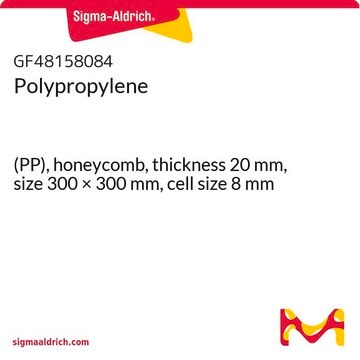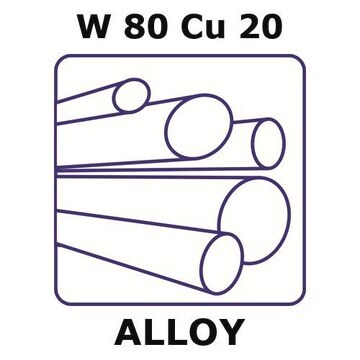Wszystkie zdjęcia(2)
Kluczowe dokumenty
GF50216352
Molybdenum
rod, 100mm, diameter 12mm, centerless ground, 99.9%
Synonim(y):
Molybdenum, MO007922
Zaloguj sięWyświetlanie cen organizacyjnych i kontraktowych
About This Item
Wzór empiryczny (zapis Hilla):
Mo
Numer CAS:
Masa cząsteczkowa:
95.94
Numer MDL:
Kod UNSPSC:
12141727
Identyfikator substancji w PubChem:
NACRES:
NA.23
Polecane produkty
Próba
99.9%
Formularz
rod
producent / nazwa handlowa
Goodfellow 502-163-52
rezystywność
5.0 μΩ-cm, 20°C
dł. × śr.
100 mm × 12 mm
bp
4612 °C (lit.)
mp
2617 °C (lit.)
gęstość
10.3 g/mL at 25 °C (lit.)
ciąg SMILES
[Mo]
InChI
1S/Mo
Klucz InChI
ZOKXTWBITQBERF-UHFFFAOYSA-N
Opis ogólny
For updated SDS information please visit www.goodfellow.com.
Informacje prawne
Product of Goodfellow
Ta strona może zawierać tekst przetłumaczony maszynowo.
Wybierz jedną z najnowszych wersji:
Certyfikaty analizy (CoA)
Lot/Batch Number
It looks like we've run into a problem, but you can still download Certificates of Analysis from our Dokumenty section.
Proszę o kontakt, jeśli potrzebna jest pomoc Obsługa Klienta
Masz już ten produkt?
Dokumenty związane z niedawno zakupionymi produktami zostały zamieszczone w Bibliotece dokumentów.
Viswanathan S Saji et al.
ChemSusChem, 5(7), 1146-1161 (2012-06-14)
The electrochemical behaviors of molybdenum and its oxides, both in bulk and thin film dimensions, are critical because of their widespread applications in steels, electrocatalysts, electrochromic materials, batteries, sensors, and solar cells. An important area of current interest is electrodeposited
Mohammad-Reza Rashidi et al.
Expert opinion on drug metabolism & toxicology, 6(2), 133-152 (2010-01-26)
Molybdenum hydroxylases, aldehyde oxidase and xanthine oxidase, are metalloflavoproteins that catalyze both oxidation and reduction of a broad range of drugs and other xenobiotics indicating the importance of these enzymes in drug oxidation, detoxification and activation. Both enzymes are also
Maria Lyra et al.
Hellenic journal of nuclear medicine, 14(1), 49-55 (2011-04-23)
The sleeping giant of molybdenum-99 ((99)Mo) production is grinding to a halt and the world is wondering how this happened. Fewer than 10 reactors in the world are capable of producing radio nuclides for medicine; approximately 50% of the world's
Ralf R Mendel
The Journal of biological chemistry, 288(19), 13165-13172 (2013-03-30)
The transition element molybdenum needs to be complexed by a special cofactor to gain catalytic activity. Molybdenum is bound to a unique pterin, thus forming the molybdenum cofactor (Moco), which, in different variants, is the active compound at the catalytic
Chantal Iobbi-Nivol et al.
Biochimica et biophysica acta, 1827(8-9), 1086-1101 (2012-12-04)
Molybdenum cofactor (Moco) biosynthesis is an ancient, ubiquitous, and highly conserved pathway leading to the biochemical activation of molybdenum. Moco is the essential component of a group of redox enzymes, which are diverse in terms of their phylogenetic distribution and
Nasz zespół naukowców ma doświadczenie we wszystkich obszarach badań, w tym w naukach przyrodniczych, materiałoznawstwie, syntezie chemicznej, chromatografii, analityce i wielu innych dziedzinach.
Skontaktuj się z zespołem ds. pomocy technicznej








